Introduction
I never invest in a common stock without a clear expectation of the future returns that it can generate for me. Consequently, I consider this one of the most important steps in my research and due diligence process. Unfortunately, my experience in dealing with investors has led me to conclude that this important step is rarely taken. Most investors possess only a vague idea of what they might earn from investing in a given stock. Many people simply buy a stock hoping that it will go up, and if it pays a dividend, hopeful that the dividend will increase over time.
With this article, I’m going to share my specific process on how I estimate the future return that a stock can be expected to offer me. My primary example will be based on a current investment in the blue-chip Dividend Aristocrat Johnson & Johnson (NYSE:JNJ). Through this exercise I will offer a methodical approach designed to determine whether Johnson & Johnson is a viable investment choice at today’s valuation.
Johnson & Johnson: Forecasting Future Returns
In part 1 of this two-part series I reviewed Johnson & Johnson (JNJ), Consolidated Edison, Inc (NYSE:ED) and Cisco Systems Inc (NASDAQ:CSCO) from a historical perspective. Reviewing a company’s history and how the market has typically valued the company’s operating results is typically the initial step in my due diligence process. However, I consider forecasting the future potential of any company the most crucial step in my due diligence process.
Directly stated, I will never invest in a stock until I have made a determination of what rate of return the investment might potentially produce for me. This is essentially done under a most likely case, best case and worst case scenarios. I’m not naïve enough to believe that I can make these calculations with absolute precision. Instead, my objective is to determine future return possibilities within reasonable ranges of accuracy and predictability. But most importantly, this gives me more that a vague idea of what the return potential that a company might produce for me. I call this investing with my eyes wide open.
However, before I move on to my forecasting process, I would like to briefly review what I saw when I examined Johnson & Johnson’s valuation history over different time periods. You can examine my historical approach more comprehensively by reviewing the link to my previous article above.
In order to review historical valuations, I rely on the F.A.S.T. Graphs™ fundamentals analyzer software tool. I always start by looking at all of the company’s history available to me. The following long-term earnings and price correlated graph on Johnson & Johnson revealed two important aspects related to valuation. First of all, I noticed that the market applied a premium valuation on Johnson & Johnson shares from 1997 through the spring of 2007. However, from that point forward the market was valuing Johnson & Johnson’s shares at a lower valuation. I have drawn a line on the graph separating these two time periods. Note that the normal P/E ratio calculation of 20.2 is high because it is skewed by the high valuations over these first 10 years or so.
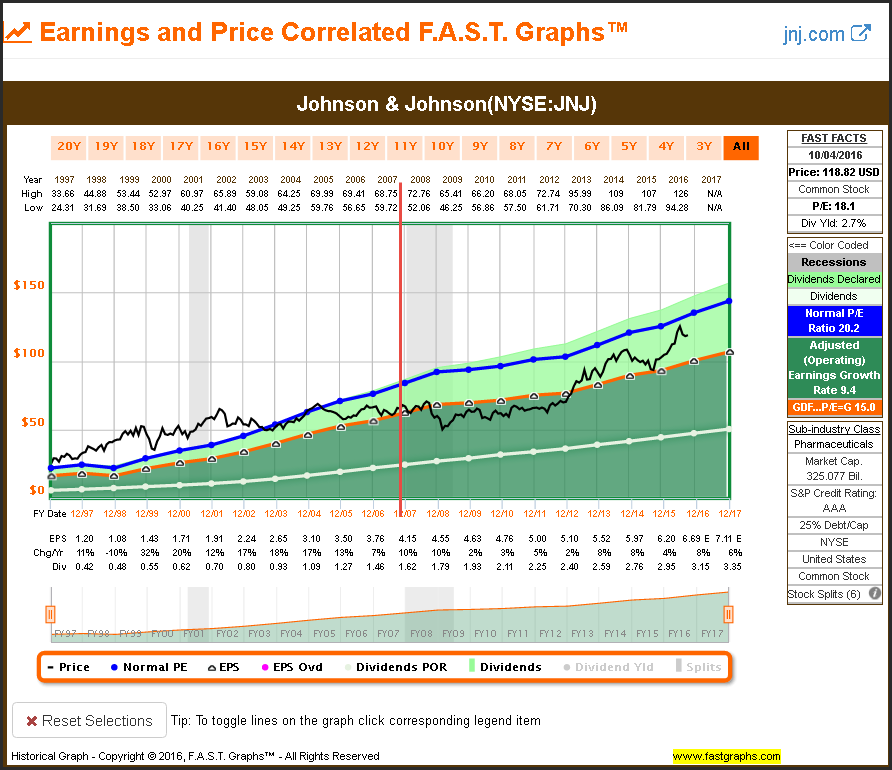
When I shortened the timeframe to cover the period 2006 to current, I discovered that the normal P/E ratio that the market has applied over this timeframe has been approximately 15. Importantly, I consider these more recent valuation levels more relevant. Therefore, my fair value assessment for Johnson & Johnson is set at the more conservative P/E ratio of 15 than at the longer-term normal P/E ratio of 20.2. Consequently, with the current blended P/E ratio at 18.1, I would consider Johnson & Johnson moderately overvalued at these levels. As promised, what follows will be the rate of return calculations I believe this valuation level offers.
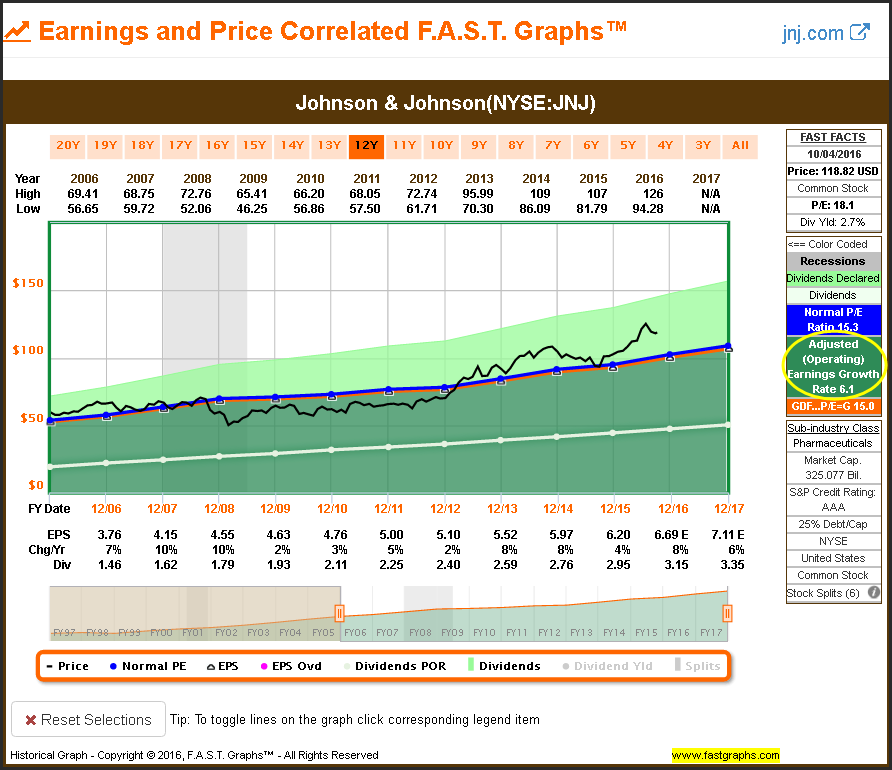
When writing articles like this I can only include a picture of a live fully functioning graph. Therefore, I have arranged to have a live fully functioning F.A.S.T. Graphs™ available to readers. Next I will offer a few simple calculations utilizing the Forecasting Calculators and their calculating functionality. However, the calculators allow me to run numerous “what-if” calculations based on various assumptions. If the reader follows the below link they will be able to quickly and easily run as many of their own calculations as they desire.
Here is the link for a FAST and FUN Preview of F.A.S.T Graphs using the stock symbol JNJ
Once you follow the link, scroll down to the Forecasting Calculators where you will find five calculators that can be utilized to estimate the future return potential on Johnson & Johnson. Each calculator is color-coded and the following screenshot illustrates how to access each calculator. My first calculation will be based on utilizing Johnson & Johnson’s normal P/E ratio of 15 (the dark blue tab and border).

The calculator is presenting forecasts based on the consensus analyst estimates reporting to S&P Capital IQ. With this Johnson & Johnson example there are 23 analysts forecasting earnings for fiscal year-end December 2016 and 25 analysts forecasting earnings for fiscal year-end 2017. From there, the number of analysts drops off to 17 analysts for fiscal year-end 2018 and only 11 analyst for fiscal year-end 2019. This information is found at the bottom of the graph as “# Analysts.”
Assuming that these analysts are reasonably correct, and the company’s stock price was valued at a normal P/E ratio of 15.3 (red circle), then Johnson & Johnson would be expected to deliver a total annualized rate of return of only 3.57% out to December 31, 2019. Personally, I would consider this too low of a rate of return potential which is due to moderately high current valuation. I consider this, as I will elaborate later, my most reasonable case scenario.
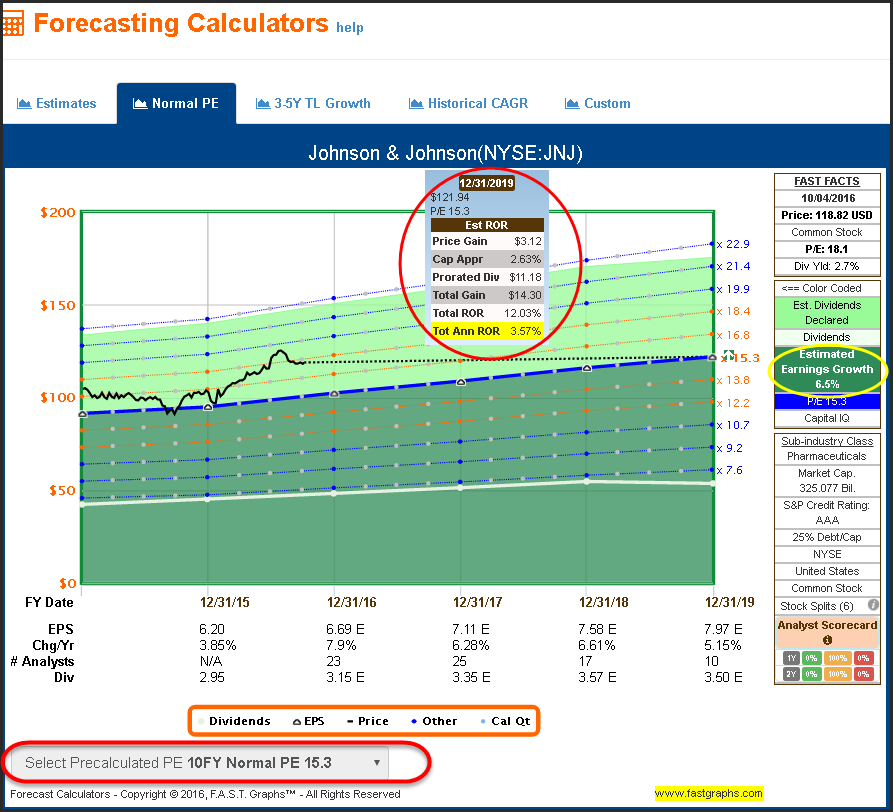
In contrast, if I ran these calculations utilizing the long-term historical normal P/E ratio of 20.1 (red circle), the investment in Johnson & Johnson looks a lot more attractive. Although I would consider this a possibility, my confidence that Johnson & Johnson would trade at that valuation is low. Therefore, I would consider this more of an optimistic or best case scenario. Nevertheless, the 11.97% total annual rate of return would be considered attractive.

At this point, I’ve run these expected and best case scenarios utilizing the specific consensus analyst estimates over the next few years. However, many investors hold a rather jaundice view of the accuracy of analyst estimates. On some companies these negative views on analyst estimates are justified, however, there are certain companies where the analysts’ track records have been exceptional. Johnson & Johnson happens to be one of those companies that analysts have tended to estimate correctly.
The following “Analyst Scorecard” summary shows that analysts have been accurate with their forecasts on Johnson & Johnson virtually 100% of the time. This record assumes a 10% margin of error for forecasts made one year in advance, and a 20% margin of error for forecasts made two years in advance.

This next screenshot provides a more detailed look at the record of analysts making a one year in advance forecast of earnings on Johnson & Johnson. Therefore, I think it is reasonable to assume two things about Johnson & Johnson’s estimates. One, Johnson & Johnson must be a relatively easy company to make forecasts on. Two, in my opinion, since analysts rely heavily on company guidance, Johnson & Johnson’s management must give good solid guidance. However, the main point I am making with these scorecards is that my confidence level is high regarding the earnings forecasts in the above calculators. Therefore, I feel it is highly likely that they would turn out to be reasonably accurate.
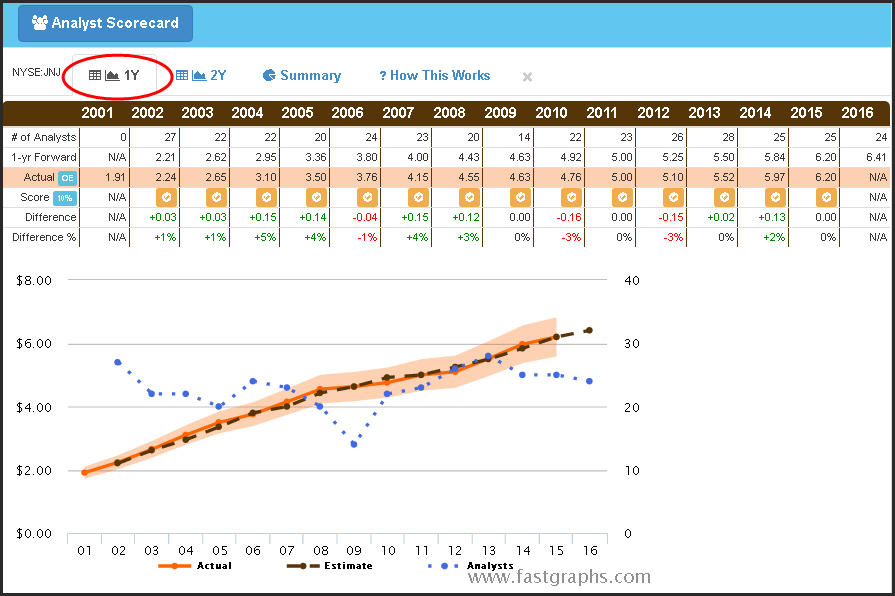
Once I have run calculations utilizing specific consensus estimates for the next few years, I like to examine the return possibilities utilizing a longer-term 3 to 5-year trend line calculation. The calculator utilized to run these calculations would be found on the third tab on the forecasting calculators’ options.

There are 9 analysts (see FAST FACTS box to the right of the graph) offering a 3 to 5-year trend line earnings growth estimate on Johnson & Johnson at 6.07% on average. If those trend line estimates happen to come to pass and Johnson & Johnson traded at a P/E ratio of 15 on December 31, 2001, it would only offer me a 4.8% rate of return. Once again, I would not be too excited about that long-term rate of return possibility notwithstanding Johnson & Johnson’s impeccable quality.
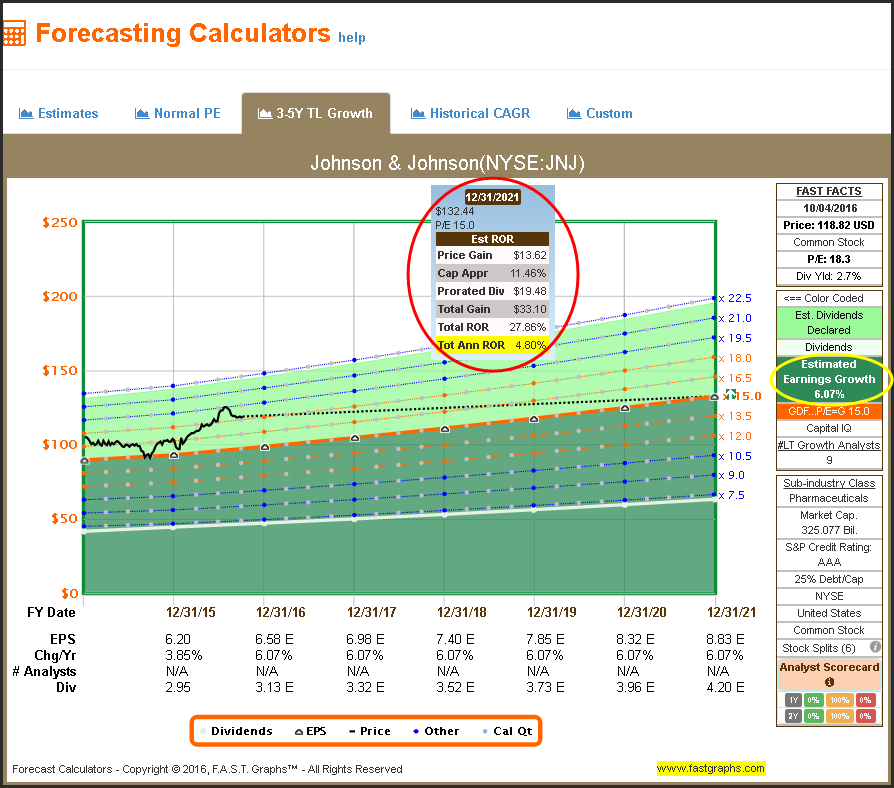
On the other hand, if I utilize that same growth expectation but applied the long-term normal P/E ratio of approximately 21, my rate of return potential would be much more attractive. However, recent historical data suggests that valuation level might be overly-optimistic. Nevertheless, this would be another possible best case scenario.
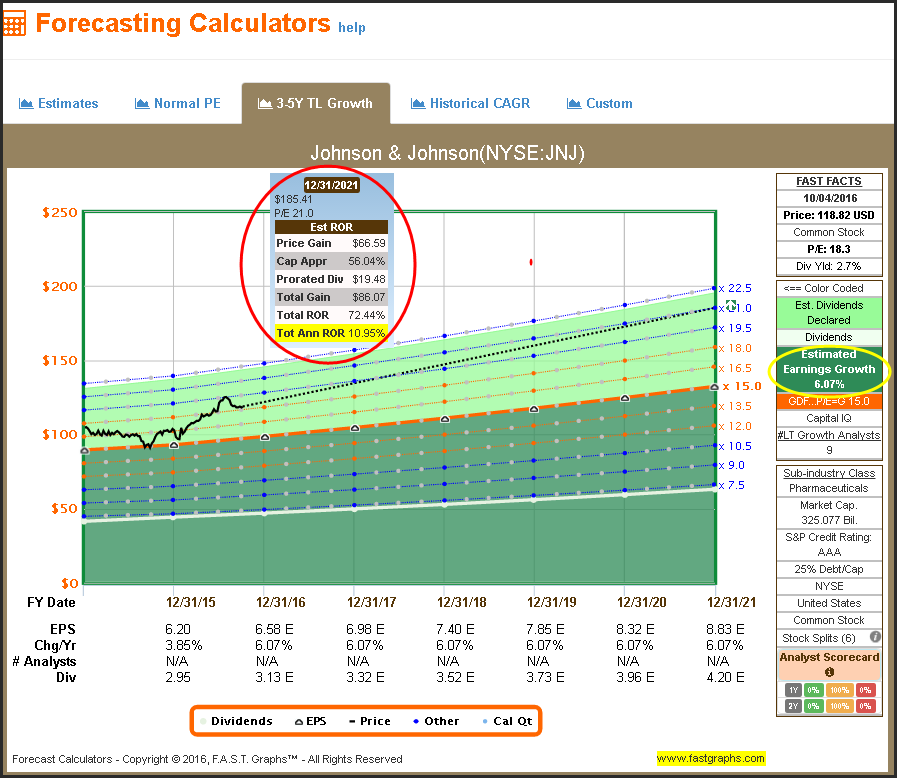
Once I have examined the consensus trend line estimates based on analysts reporting to S&P Capital IQ, I like to check other sources to see what other analysts think. Therefore, I checked the five-year growth forecast on Johnson & Johnson from Morningstar. Here I found a much lower estimate for longer-term growth of only 3.8% on average.
“Morningstar Five-Year Growth Forecast”

Consequently, I then went to the “Custom” calculator option and entered a custom trend line growth rate of 3.8% (red circle) according to Morningstar. Once again, utilizing the normal P/E ratio of 15, my rate of return calculation on Johnson & Johnson based on Morningstar estimates only averaged 2.35% per annum. Perhaps this could be considered a worse case - or maybe even just a bad case scenario for this blue-chip Dividend Aristocrat. Nevertheless, it provides additional insights generated by my due diligence process.
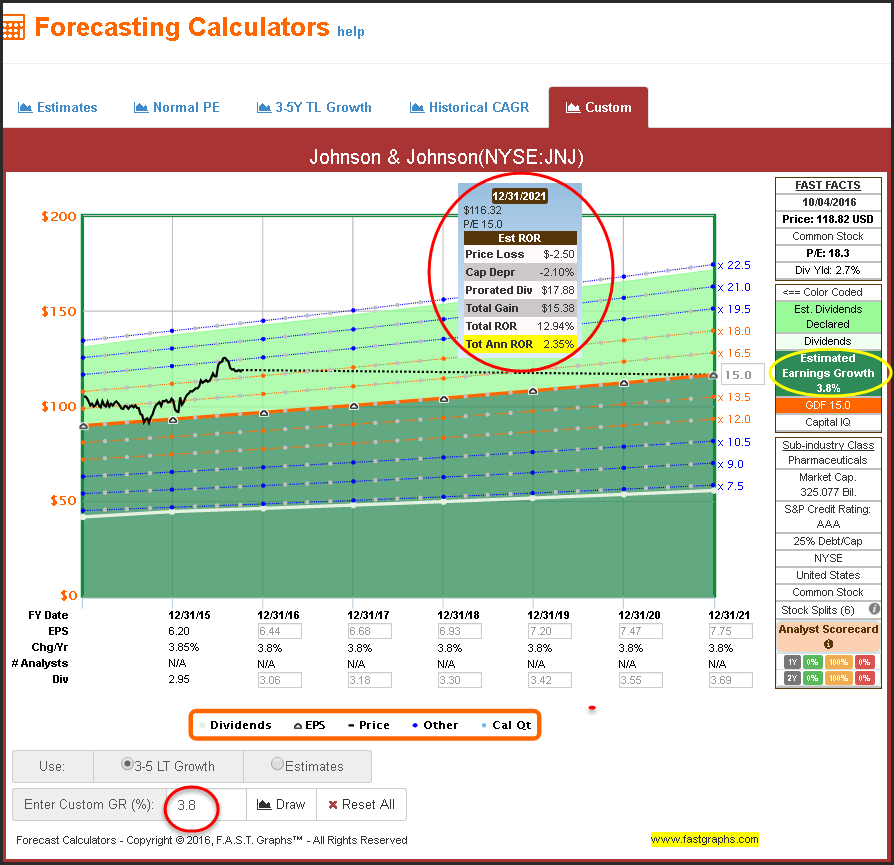
Additionally, I often like to run rate of return calculations where I utilize historical earnings growth rates in lieu of analyst estimates. This is an approach that Ben Graham suggested. This next calculation utilizes the “Historical CAGR” (Compound Annual Growth Rate) of 5% (red circle) on average for Johnson & Johnson over the past 5 completed historical years. All things considered, I consider this 5% growth rate achievable for Johnson & Johnson. Consequently, I would consider this a plausible case scenario.
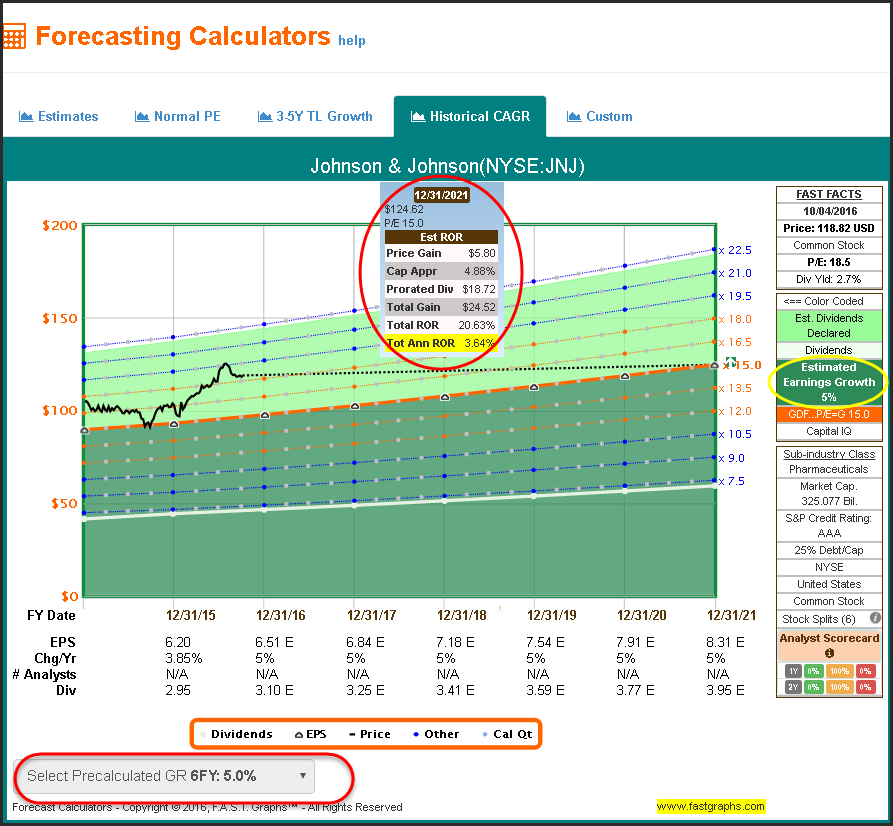
However, I never stop with just running calculations based on analyst estimates or historical earnings growth rates on any company I am researching. My next step is to check other research providers in order to assess the validity of the assumptions utilized in my calculations. What follows is one example utilizing Morningstar research and their discussion of Johnson & Johnson’s economic moat. However, I will check several other research providers for additional information as well.
“Morningstar Research: Economic Moat 07/19/2016
We believe Johnson & Johnson carries one of the widest moats in the healthcare sector, supported by intellectual property in the drug group, switching costs in the device segment, and strong brand power from the consumer group. The company's diverse revenue base, strong pipeline, and robust cash flow generation create a very wide economic moat. An extensive salesforce makes J&J a powerful candidate for a smaller biotechnology company looking to partner on a new drug, which strengthens Johnson & Johnson's ability to bring new products to market.Johnson & Johnson's diverse operations are a major pillar supporting the wide moat. The company holds a leadership role in a number of segments, including medical devices, OTC medicines, and several drug markets. Further, the company is not overly dependent on one particular operating segment; the pharmaceutical business, medical device group, and consumer products represent 40%, 40%, and 20% of total sales, respectively. Additionally, within each segment no one product dominates sales, as Pfizer (NYSE:PFE)'s Lipitor did. Despite carrying some lower-margin divisions, J&J maintains strong pricing power and has posted gross margins above 68% during the past five years, validating its strong competitive position.”
Finally, after checking numerous research sources, I like to conclude my due diligence by going to the company’s website to see what they have to say about their future. The following excerpts are from Johnson & Johnson 2nd Quarter 2016 Earnings Presentation:

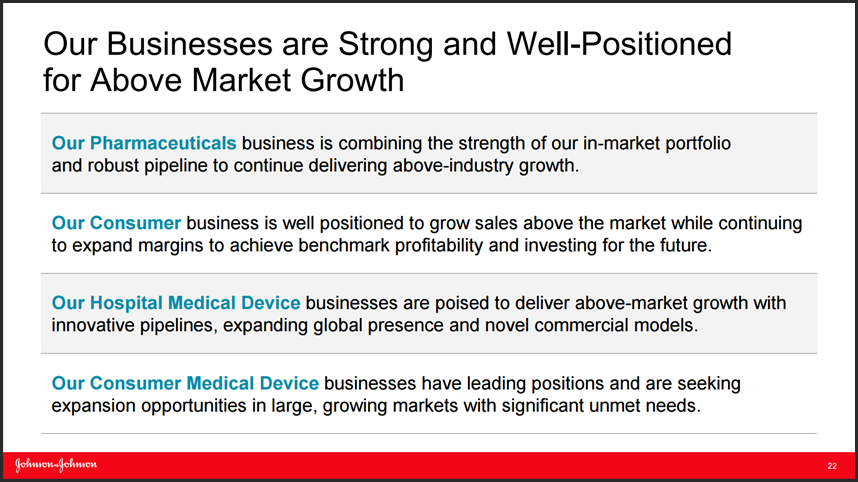

One of the areas I am most interested in is the company’s earnings guidance. The following slides and the accompanying F.A.S.T. Graphs™ Forecasting Calculator illustrate that the company guidance and analysts’ estimates are aligned. The 2016 earnings forecast of $6.69 is in the middle of the guidance range provided by Johnson & Johnson.
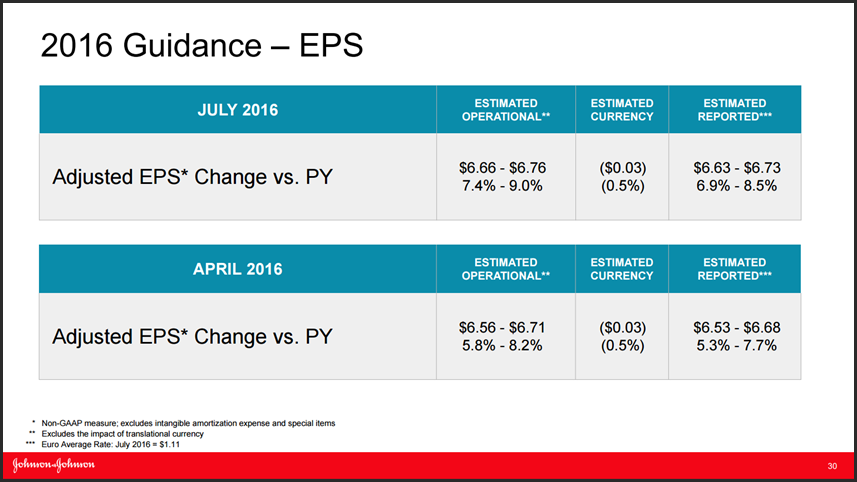
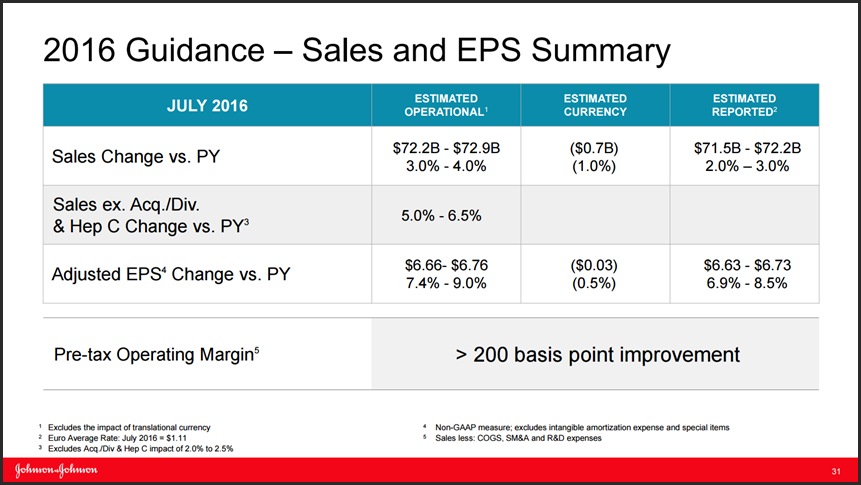
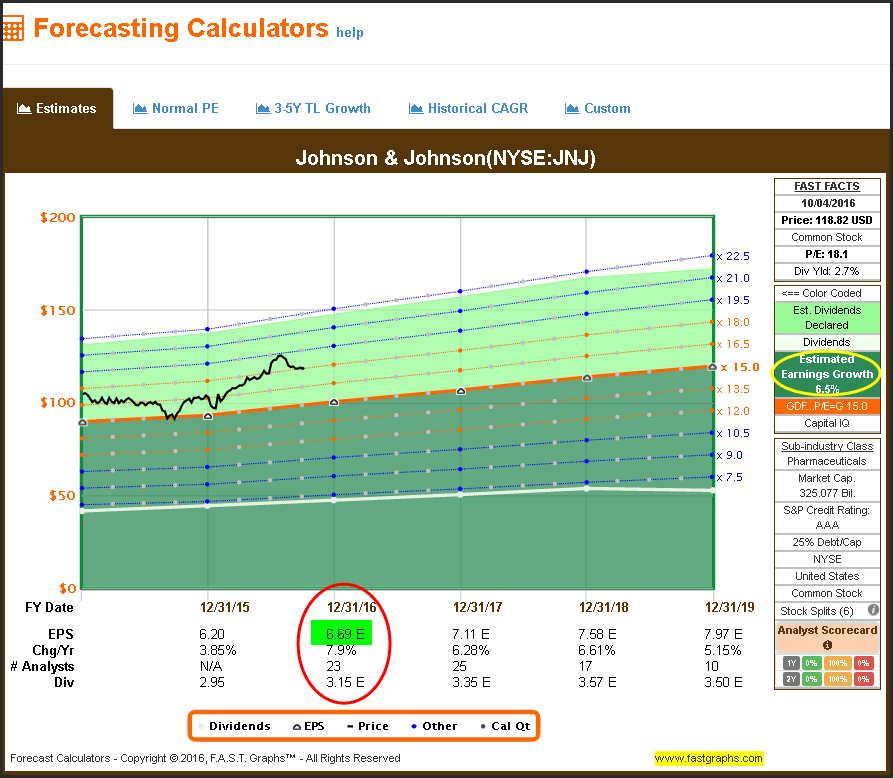
Johnson & Johnson – Why I’m Not Selling
After running the above return calculations for Johnson & Johnson going forward utilizing various scenarios, I have concluded that I do not consider Johnson & Johnson a compelling investment at today’s valuation. However, I make a distinction between making a buy decision versus a sell decision.
The following historical graphs on Johnson & Johnson are marked with a green dot indicating the day that I bought this blue-chip. With the first graph, I have run a calculation of the rate of return I have achieved on my Johnson & Johnson investment thus far. As you can see, this has been a very profitable holding. Because I purchased the stock when it is undervalued, and considering that it is now moderately overvalued, my results have been better than what the company produced on an operating basis.
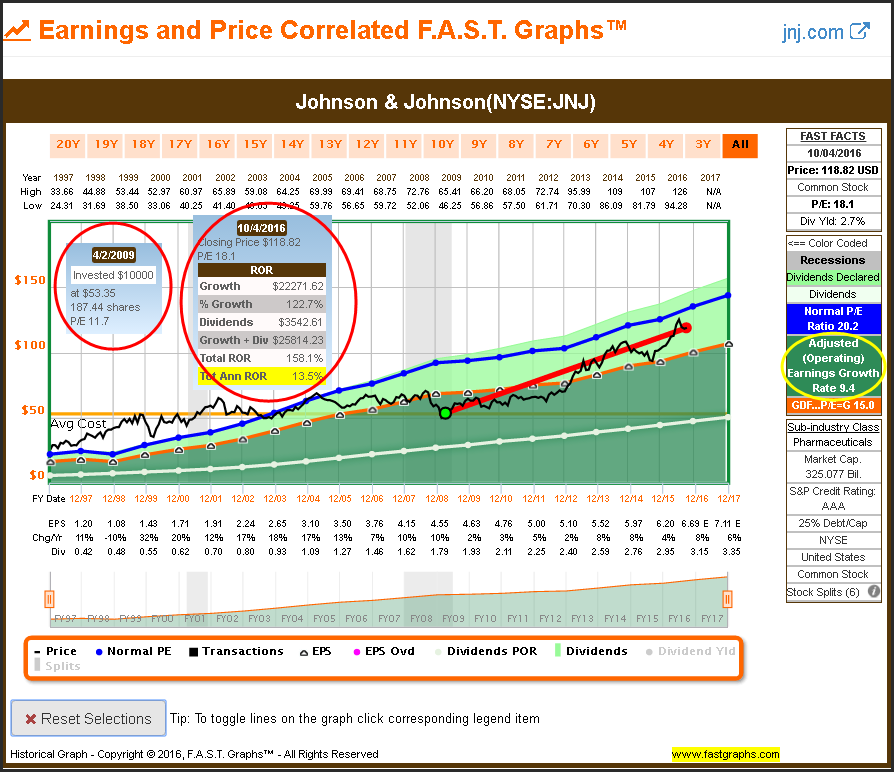
With such a nice profit on my investment, it would be very tempting to sell and harvest that return. However, one of my primary reasons for investing in the stock was the company’s impeccable history of increasing their dividend every year. Consequently, if I sold, I would be giving up that future dividend. But as previously suggested, I believe in investing with my eyes wide open.
Therefore, I have run a calculation to see what my rate of return would be if the company reverted to the mean by year-end 2017. Obviously, if that happened it would be lower. On the other hand, I would still be earning a double-digit return. And of course, there is the possibility that Johnson & Johnson’s stock price would maintain its current P/E ratio. Once I’ve established a solid position in a great business like Johnson & Johnson, I am very reluctant to sell unless valuations become extreme. I don’t consider Johnson & Johnson’s current valuation extreme; therefore, I plan on continuing to hold it for a long time.
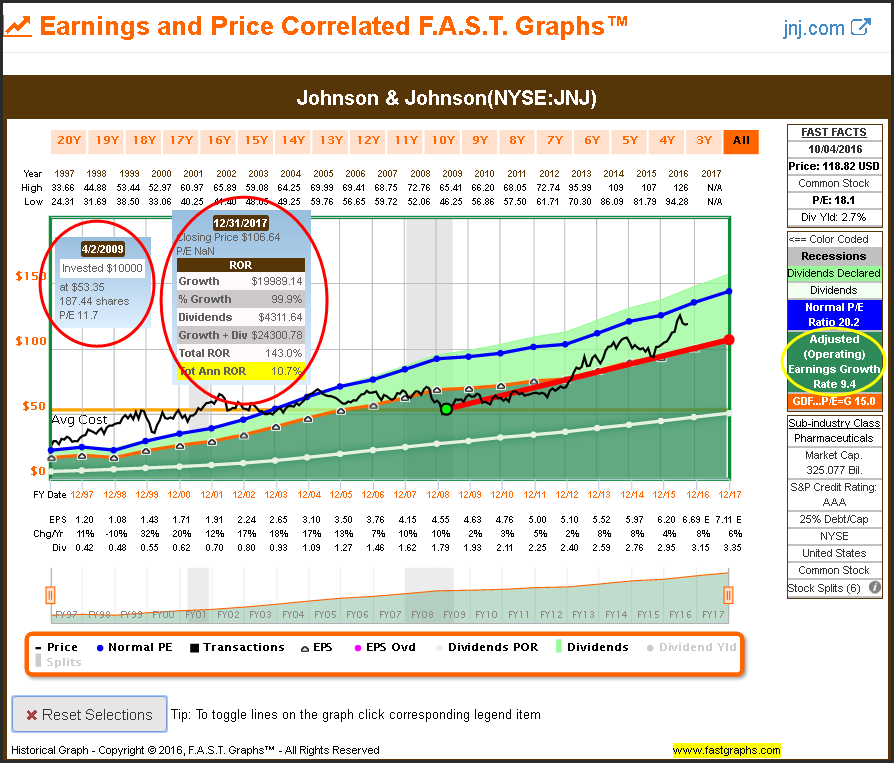
The Bottom Line
I hope the reader recognizes that the primary message I’m attempting to deliver with the above exercise is to always invest with your eyes wide open. To me this means establishing a reasonable expectation of what the business behind the stock is capable of delivering, and then calculates a reasonable rate of return expectation on that basis. In other words, never invest on just a hope or a prayer.
Follow-up Examples From Part 1
In part 1 of this two-part series I covered two additional companies. Therefore, in this part 2 I wanted to give the reader the opportunity to run their own calculations regarding the future return potential of Consolidated Edison, Inc. and Cisco Systems, Inc. However, I will spare the reader from repeating the exercise as I did with Johnson & Johnson above. Instead, below I have provided links to live fully functioning F.A.S.T. Graphs™ on both of these companies. Additionally, I have provided a few screenshots just to get you started - you choose to take the opportunity to follow the links and run your own calculations.
Consolidated Edison, Inc.
Here is the link for a FAST and FUN Preview of F.A.S.T Graphs using the stock symbol ED

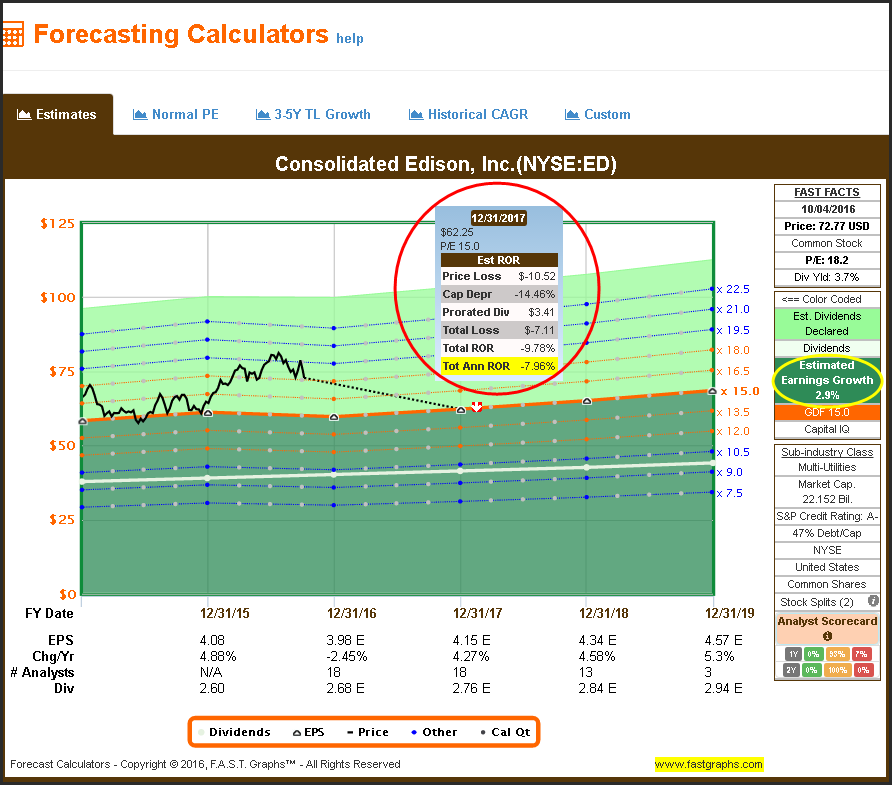
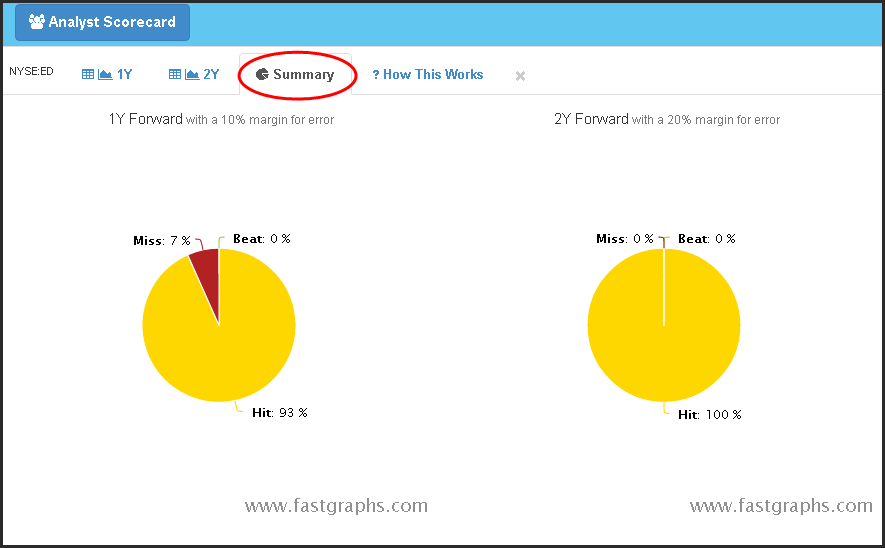
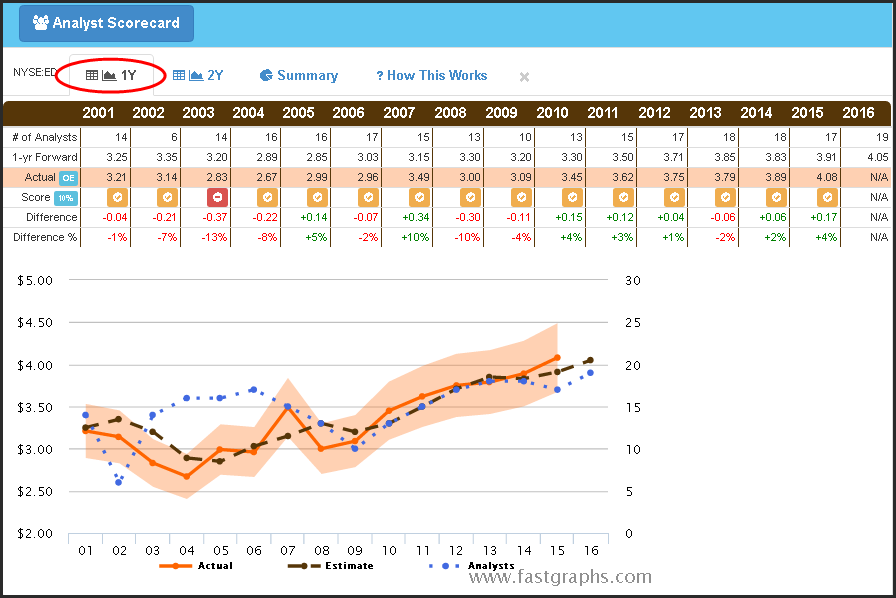
Cisco Systems, Inc.
Here is the link for a FAST and FUN Preview of our F.A.S.T Graphs using the stock symbol CSCO

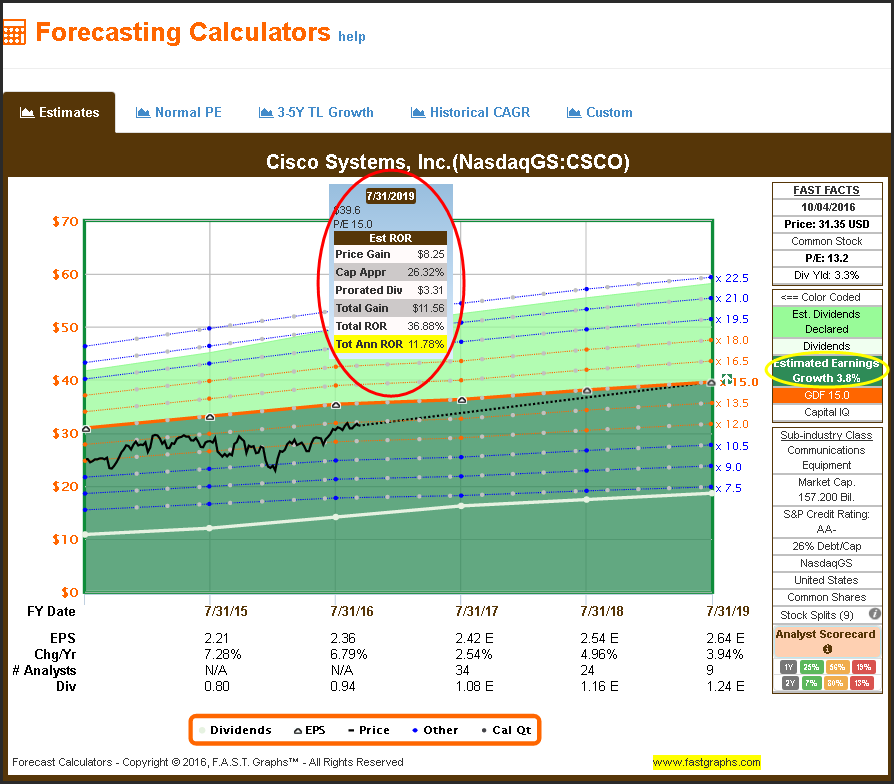
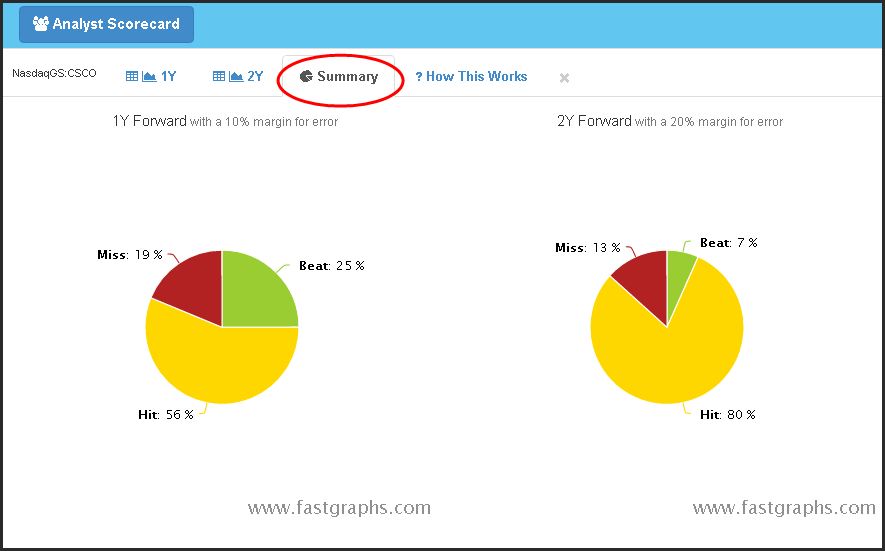
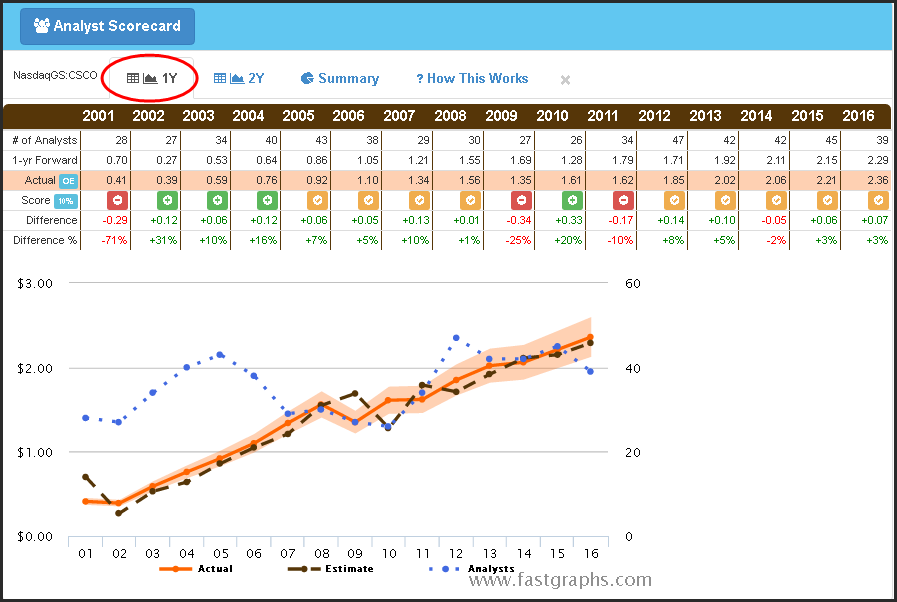
Summary and Conclusions
As I stated in part 1 of this two-part series, common stocks come in all sizes and shapes. There are certain companies that might be attractive based on their dividend yields. Other companies might be attractive based on their future growth potential. And, of course, there is everything in between. This simply implies that different types of companies are capable of producing significantly different future rates of return. The primary drivers will be the growth potential of each business, coupled with the valuation you paid to purchase those results.
The key to success is to identify the types of companies you are comfortable investing in, and that are capable of meeting your own goals and objectives. However, I believe that no matter how much you like the company, you should always be keenly aware of the valuation you are being asked to pay. One of the best ways to implement and apply a disciplined approach to investing is to run the numbers out to their logical conclusions.
With this article, I utilized the “Forecasting Calculators” provided by the F.A.S.T. Graphs™ research tool. However, the same process could be applied utilizing a simple spreadsheet. Earnings estimates are available from many sources, and there is never a substitute for conducting your own comprehensive research and due diligence. My key message with this article is to always invest with your eyes wide open.
Disclosure: Long JNJ,ED,CSCO
Disclaimer: The opinions in this document are for informational and educational purposes only and should not be construed as a recommendation to buy or sell the stocks mentioned or to solicit transactions or clients. Past performance of the companies discussed may not continue and the companies may not achieve the earnings growth as predicted. The information in this document is believed to be accurate, but under no circumstances should a person act upon the information contained within. We do not recommend that anyone act upon any investment information without first consulting an investment advisor as to the suitability of such investments for his specific situation.
